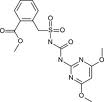Products >>Herbicide >> Bensulfuron-methyl
Bensulfuron-methyl
Bensulfuron-methyl 95%TC, Bensulfuron-methyl 60%WDG
Herbicide
HRAC B WSSA 2; sulfonylurea

NOMENCLATURE
bensulfuron-methyl
Common name bensulfuron-methyl
Chemical Abstracts name methyl 2-[[[[[(4,6-dimethoxypyrimidin-2-yl)-amino]carbonyl]amino]sulfonyl]methyl]benzoate
CAS RN [83055-99-6] EEC no. 401-340-6 Development codes DPX-F5384
(Du Pont)
bensulfuron
Common name bensulfuron (BSI, ANSI, WSSA, draft E-ISO, (m) draft
F-ISO)
IUPAC name a-(4,6-dimethoxypyrimidin-2-ylcarbamoylsulfamoyl)-o-toluic
acid
Chemical Abstracts name 2-[[[[[(4,6-dimethoxy-2-pyrimidinyl)amino]carbonyl]amino]sulfonyl]methyl]benzoic
acid
CAS RN [99283-01-9]
bensulfuron
Mol. wt. 396.4 M.f. C15H16N4O7S
APPLICATIONS
Biochemistry Branched chain amino acid synthesis (ALS or AHAS) inhibitor.
Acts by inhibiting biosynthesis of the essential amino acids valine
and isoleucine, hence stopping cell division and plant growth. Selectivity
is due to rapid metabolism in the crop. Metabolic basis of selectivity
reviewed (M. K. Koeppe & H. M. Brown, Agro-Food-Industry, 6,
9-14 (1995)). Mode of action Selective systemic herbicide, absorbed
by the foliage and roots, with rapid translocation to the meristematic
tissues. Uses Selective pre- and post-emergence control of annual
and perennial weeds and sedges (e.g. Butomus umbellatus, Scirpus
maritimus, Scirpus mucronatus, Alisma plantago-aquatica, Sparganium
erectum, Cyperus spp., Typha spp., etc.) in continuously flooded
rice, at 30-100 g/ha. Formulation types GR; WG; WP. Selected tradenames:
'Londax' (Du Pont); mixtures: 'Fujigrass' (+ esprocarb) (Du Pont,
Syngenta); 'Kusastop' (+ indanofan) (Mitsubishi Chemical); 'Wolf-Ace'
(+ mefenacet+ thiobencarb) (Kumiai); 'Zark' (+ mefenacet) (Du Pont,
Kumiai, Nihon Bayer, Sankyo)
OTHER TRADENAMES
bensulfuron-methyl
'Rozal' (Du Pont); 'Escuri' (Crystal); 'Papika A I Kilo' (Nihon
Nohyaku, Hokko) mixtures: 'Bazooka A' (+ azimsulfuron+ cyhalofop-butyl)
(Nihon Nohyaku, Hokko, Tokuyama, Du Pont); 'Bazooka' (+ cyhalofop-butyl+
thenylchlor) (Nihon Nohyaku, Hokko, Tokuyama, Du Pont); 'Papika
A' (+ azimsulfuron+ cyhalofop-butyl+ thenylchlor) (Tokuyama, Nihon
Nohyaku, Hokko, Du Pont); 'Papika' (+ cyhalofop-butyl+ thenylchlor)
(Tokuyama, Nihon Nohyaku, Hokko, Du Pont); 'Sindax' (+ metsulfuron-methyl)
(Du Pont); 'Weedless A36' (+ azimsulfuron+ cafenstrole+ daimuron)
(Sankyo, Du Pont, Eikou Kasei, SDS Biotech KK); 'Cao Neng' (+ quinclorac)
(Anhui); 'Dancing A' (+ azimsulfuron+ indanofan) (Mitsubishi Chemical);
'Dancing L' (+ indanofan) (Mitsubishi Chemical); 'Dancing-Power
A' (+ azimsulfuron+ clomeprop+ indanofan) (Mitsubishi Chemical);
'Dancing-Power L' (+ clomeprop+ indanofan) (Mitsubishi Chemical);
'Dinaman' (+ clomeprop+ indanofan) (Mitsubishi Chemical); 'Inegreen
D' (+ cyhalofop-butyl+ daimuron+ mefenacet) (Nihon Bayer); 'Inegreen'
(+ cyhalofop-butyl+ mefenacet) (Nihon Bayer); 'Joystar' (+ cafenstrole+
cyhalofop-butyl+ daimuron) (Kumiai); 'Karshot' (+ pyributicarb)
(Sankyo); 'Kusamets FL' (+ thenylchlor) (Nihon Nohyaku, Tokuyama,
Hokko); 'Kusastop A' (+ azimsulfuron+ indanofan) (Mitsubishi Chemical);
'Kusatory Ace Jumbo' (+ cafenstrole+ daimuron) (Sankyo); 'Kusatory
E Jumbo' (+ pyributicarb) (Sankyo); 'Londanil' (+ propanil) (Crystal);
'Masakari A Jumbo' (+ azimsulfuron+ clomeprop+ indanofan) (Mitsubishi
Chemical); 'Masakari L Jumbo' (+ clomeprop+ indanofan) (Mitsubishi
Chemical); 'Non-Poong' (+ benfuresate) (Aventis); 'Push' (+ dimepiperate)
(Hokko); 'Rakudar' (+ cafenstrole+ daimuron) (Sankyo); 'Ranger'
(+ benfuresate+ dimepiperate) (Aventis, Hokko); 'Tabijin A' (+ azimsulfuron+
cyhalofop-butyl+ pretilachlor+ pyriminobac-methyl) (Kumiai); 'Weedless'
(+ cafenstrole+ daimuron) (Sankyo); 'Zark D' (+ daimuron+ mefenacet)
(Sankyo) Discontinued names: 'Mariner' * (Du Pont) mixtures: 'Kusatory
Jumbo' * (+ daimuron+ pyributicarb) (Sankyo)
ANALYSIS
Product and residue analysis by hplc. Methods for sulfonylurea residues
in crops, soil and water reviewed (A. C. Barefoot et al., Proc.
Br. Crop Prot. Conf. - Weeds, 1995, 2, 707). Details from Du Pont.
MAMMALIAN TOXICOLOGY
bensulfuron-methyl
Oral Acute oral LD50 for rats >5000, mice >10 985 mg/kg. Skin
and eye Acute percutaneous LD50 for rabbits >2000 mg/kg. Non-irritant
to skin and eyes. Inhalation LC50 (4 h) for rats >7.5 mg/l air.
NOEL (2 y) for rats 750 mg/kg diet. Reproduction (2-generation)
NOEL in rats 7500 mg/kg diet; teratogenicity NOEL in rats 500, rabbits
300 mg/kg. Not a mutagen. ADI 0.2 mg/kg. Toxicity class WHO (a.i.)
III (Table 5); EPA (formulation) IV EC hazard R43| N; R51, R53
ECOTOXICOLOGY
bensulfuron-methyl
Birds Acute oral LD50 for mallard ducks >2510 mg/kg. Dietary
LC50 (8 d) for bobwhite quail, mallard ducks >5620 mg/l. Fish
LC50 (96 h) for rainbow trout and bluegill sunfish >150 mg/l;
LC50 (48 h) for carp >1000 ppm. Daphnia LC50 (48 h) >100 mg/l.
Bees LD50 >12.5 mg/bee.
ENVIRONMENTAL FATE
bensulfuron-methyl
Animals Almost completely biotransformed and rapidly excreted in
urine and faeces of rats and goats. Plants After uptake by rice,
converted to a non-herbicidal metabolite. Soil/Environment DT50
4-20 w on Flanagan and Keyport silt loam soils. In rice fields,
DT50 in water averages 4-6 d.